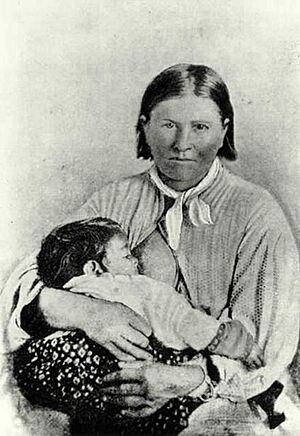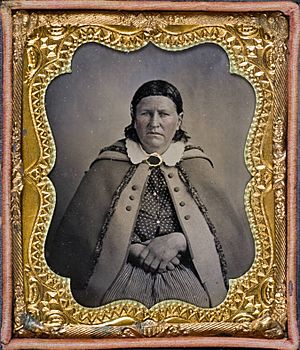Cynthia Ann Parker facts for kids
Quick facts for kids
Cynthia Ann Parker
|
|
|---|---|
| Na'ura | |

Cynthia Ann Parker, or Narua (Was Found), and daughter, Topsannah (Prairie Flower), in 1861
|
|
| Born | October 28, 1827 |
| Disappeared | May 19, 1836 (age 8) Fort Parker, Republic of Texas |
| Status | Relocated during the Pease River fight on December 18, 1860 (age 33) |
| Died | March 1871 (aged 43) Anderson County, Texas, U.S.
|
| Resting place | Fort Sill Post Cemetery |
| Known for |
|
| Spouse(s) | Peta Nocona |
| Children |
|
| Parents |
|
| Relatives | John Parker (grandfather) James W. Parker (uncle) Daniel Parker (uncle) |
Cynthia Ann Parker (born October 28, 1827 – died March 1871) was a woman who was captured by a Comanche group in 1836. This happened during the Fort Parker massacre, where some of her family members were killed. She was taken along with other relatives, including her younger brother John Richard Parker.
Cynthia Ann was adopted by the Comanche and lived with them for 24 years. She became a full member of the tribe. She married a chief named Peta Nocona and they had three children. Her Comanche name, Na'ura, means "was found" in English.
Many years later, in 1860, she was found by Texas Rangers. She was about 33 years old. She was forced to leave her Comanche family and return to live in American society. She was very sad about this and found it hard to adjust to her new life. She tried to escape at least once but was brought back. Cynthia Ann Parker died about 10 years after her return.
Her remains were moved several times after her death. In 1910, her son Quanah had her moved to a cemetery in Oklahoma. In 1957, both she and Quanah were reburied at Fort Sill Cemetery in Oklahoma. In 1965, her daughter's remains were also moved to be buried with them.
Contents
Early Life
Cynthia Ann Parker was born in Crawford County, Illinois. Her exact birth date is not known for sure, but it was likely around 1824 to 1827. When she was about nine or ten years old, her family moved to north-central Texas. Her grandfather, John Parker, helped set up a settlement called Fort Parker. This fort was built to protect the settlers from attacks by Native American groups, especially the Comanche.
Fort Parker Attack
On May 19, 1836, a large group of Native American warriors attacked Fort Parker. These warriors were mainly Comanche, with some Kiowa and Kichai allies. The settlers at the fort were not ready for how strong and fast the Comanche warriors were.
The Native Americans quickly took over the fort. They captured Cynthia Ann Parker, who was a young girl, and five other people. They took them back to Comanche lands. The Texans tried to rescue them. Over the next few years, some of the other captives were released when their families paid money. However, Cynthia Ann was adopted by a Comanche family and became a full member of their tribe. She was about nine years old when this happened.
Marriage to Peta Nocona
Cynthia Ann became completely part of the Comanche tribe. She was adopted by a Comanche couple who raised her as their own child. She married Peta Nocona, who was a chief. They had a happy marriage. Peta Nocona loved her so much that he never took another wife, even though it was common for chiefs to have several wives.
They had three children together. Their sons were Quanah, who later became the last free Comanche chief, and Pecos. They also had a daughter named Topsannah, which means Prairie Flower.
Return to Texas

In December 1860, after many years of searching, Texas Rangers found a group of Comanche. This group was rumored to have American captives. The Rangers, led by Lawrence Sullivan Ross, surprised the Comanche in a fight known as the Battle of Pease River.
During the fight, the Comanche tried to get away. Ranger Ross chased a man who seemed to be the leader, who was riding with a woman. As Ross got closer, the woman held a child above her head. The Rangers did not shoot. They surrounded and stopped her. Ross continued to chase the chief and killed him. Ross's cook identified the man as Nocona.
The Rangers then questioned the woman and other Comanche survivors. In broken English, she said her name and family name. This information matched what Ross knew about the captives taken from Fort Parker in 1836.
Ross sent Cynthia Ann and her daughter to a camp. He told her uncle, Colonel Isaac Parker, that she had been found. Her uncle took her to his home.
Many people were interested in Cynthia Ann's return to her birth family. In 1861, the Texas government gave her a large piece of land (about 4,400 acres) and money each year. Her cousins were made her legal guardians.
However, Cynthia Ann never felt comfortable in her new life. Even though she was white and lived among American settlers, she did not like the attention she received. She missed her sons and worried about them. She found it very hard to adjust to a way of life that was so different from the Comanche.
Death
In 1864, Cynthia Ann's daughter, Topʉsana, became sick with influenza and died from pneumonia. Cynthia Ann was filled with sadness. This, along with missing her sons and her Comanche life, made her stop eating and drinking. She died in March 1871 at her sister's home and was buried in a cemetery in Anderson County, Texas.
There is some confusion about her exact birth and death dates. Records show different years, but the most likely death date is March 1871.
In 1910, her son, Quanah, moved her remains to a cemetery in Oklahoma. When he died in 1911, he was buried next to her. In 1957, both their bodies were moved again to the Fort Sill Post Cemetery in Oklahoma. In 1965, the state of Texas moved Prairie Flower's body to be buried near her mother and brother.
Legacy
The city of Crowell, Texas, holds a Cynthia Ann Parker Festival to remember her. The town of Groesbeck also has an annual Christmas Festival at the rebuilt Fort Parker.
Film Portrayal
The character of Stands with a Fist in the 1990 movie Dances With Wolves was based on Cynthia Ann Parker.
Representation in Other Media
- The novel The Searchers (1954) by Alan Le May is loosely based on Cynthia Ann Parker's life.
- The movie The Searchers (1956) was based on Le May's novel.
- Ride the Wind (1982) by Lucia St. Clair Robson is a historical novel about her capture and life with the Comanche.
- Where the Broken Heart Still Beats: The Story of Cynthia Ann Parker (1992) by Carolyn Meyer is a historical novel written for children.
See also
 In Spanish: Cynthia Ann Parker para niños
In Spanish: Cynthia Ann Parker para niños




